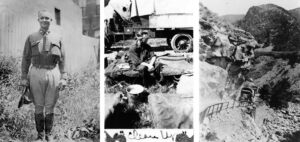When truckers are surveyed about the most difficult U.S. cities to drive through, Houston often ranks near the top of the list, with drivers jockeying through the heart of the city to access the port, railyards and other freight hubs.
With a population of nearly 7 million, the Houston area remains one of the fastest growing cities in the country. In fact, it’s currently ranked as the fourth most populated city in the U.S. behind New York, Los Angeles and Chicago.
Houston’s traffic, which actually starts about 60 miles from the city center, can be horrific. Despite several expressway loops intended to divert traffic around the city, it’s hard to avoid getting stuck in a gridlock.
Times have changed
Back in 1976, Houston — while still a large city — was far from what it is today. With a population of 2.1 million, it had become the sixth largest city in the country, having nearly doubled in size in just six years.
The roadways throughout the city weren’t designed for the increased traffic. Despite double-decker roads and numerous overpasses, only two interstates served the area, with other feeder routes into the city via the U.S. highways. Just one loop, Interstate 610, encircled the city — and it was still under construction.
I don’t know what truckers thought of Houston traffic in 1976. I do know, however, that it came under close scrutiny in May of that year.
Worst accident in Houston’s history
On May 11, 1976, one of the worst trucking accidents in Houston’s history took place at 11:08 a.m.
At that time, a truck hauling a tanker holding 7,509 gallons of anhydrous ammonia lost control while weaving through heavy traffic. It crashed through a guardrail and flew off the side of a highway ramp where I-610 meets U.S. 59 (the Southwest Freeway). After striking a support column on the way down, the truck landed approximately 15 feet below the overhead freeway.
The tractor and trailer separated on impact and one end of the tank was ripped off. The liquid ammonia was released at 90 pounds per square inch through the 86-inch-diameter opening, resulting in a deadly cloud of ammonia over the area.
When anhydrous ammonia comes into contact with moisture, it changes from a liquid to a solid lye-like substance. Those who came into contact with the ammonia found themselves coated in the chemical, particularly around the eyes, nose and mouth.
Survivors reported feeling like their skin was on fire. Inhaling the ammonia fumes created a similar internal reaction that damaged victims’ trachea and lungs, resulting in six deaths, including another truck driver.
The driver was killed in the accident — and the crash spelled disaster for nearly 200 others. Seven people, including the tanker driver and the driver of another truck, died. A total of 178 people were injured, many of them due to ammonia inhalation.
The freeway was closed for 3 miles in all directions and those who could smell ammonia were instructed to leave their homes.
At the end of this story is a video showing a local news report from the time of the accident.
To view coverage of the 1976 incident by ABC13 Houston on YouTube, click here.
Deadly cloud
According to a 1979 report by the National Traffic Safety Board (NTSB), some of the ammonia vaporized and formed a large cloud. The chemical cloud rose when it came into contact with the warm May air; then a 7 mph wind blew the cloud about 3,000 feet to the south, where it directly impacted hundreds of people along the freeway.
Ditches adjacent to the freeway filled with liquid ammonia, and the substance boiled. Some of the injured fled the highway, running into these low areas. Many were overcome by the fumes.
According to the NTSB report, those leaving their vehicles were most prone to injury. Several victims reported what appeared to be a “blinding snowstorm.” Because it was a warm day and most drivers had their air conditioners on and windows rolled up, there was no strong ammonia odor at first.
Motorists who left their vehicles and tried to flee the area, either holding their breath or breathing through a layer of clothing, encountered a strong ammonia odor and fumes that caused eye irritation, vision impairment (or even blindness), nausea, disorientation and choking.
Many disoriented victims tried to outrun the chemical cloud but were hampered by obstacles like roadside fencing. Some fell to the ground and continued to crawl in an attempt to escape the noxious fumes.
At the time, the Houston Fire Department wasn’t equipped to handle such an event. Their solution to the ammonia problem was to spray water into the ditches that were filled with liquid ammonia, raising the boiling point and diluting the chemical.
What happened?
The NTSB’s report pointed to three probably causes of the accident:
- Excessive speed: The truck was reported as traveling at an excessive speed at the time it struck the support beam and left the overpass; this is noted as the primary cause of the accident.
- Lateral surge of liquid: The force of over 7,000 gallons of anhydrous ammonia was less than a full load and shifted in the tanker, causing the truck to overturn.
- Failure of the overpass railing: The NTSB noted the “failure of the bridge rail to contain or redirect the vehicle” was a contributing factor in allowing the truck to fall from the overpass to the freeway below.
Steps taken to prevent similar accidents
At the time of the 1976 crash and spill, hazardous materials were not allowed on I-45 or I-10 through Houston’s downtown area. However, I-610 was a legal hazardous material route —with no limit on the size of loads that could be hauled.
According to the NTSB, “In 1970, I-610 was not heavily traveled and had few office buildings nearby. By 1976, the vehicular traffic had increased to more than 70,000 vehicles daily, and high-rise commercial and residential complexes lined the entire route.”
Immediately after the accident, television newscasters called for officials to reexamine the routes, taking into consideration the population growth of the area. Eventually, officials set limits on the amount of hazardous materials that could be hauled along the I-610 corridor to prevent such a large incident from happening again.
The 1976 ammonia incident remains the worst traffic accident in Houston’s history.
Perhaps memories of the accident led to truck drivers’ dislike of driving through the Houston area — or maybe it’s just because traffic is so heavy that drive times are extended. In either case, Houston is a major hub for hauling hazardous materials. Chemicals, petroleum and gasoline are frequently hauled from the refineries and the Port of Houston.
Even though Houston has grown nearly four-fold in the ensuing 49 years, no accident has approached the severity of that 1976 incident. It may be luck — or perhaps it’s the evolution of America’s freeways and hazardous materials regulations that have protected the area from a similar incident.
Since retiring from a career as an outdoor recreation professional from the State of Arkansas, Kris Rutherford has worked as a freelance writer and, with his wife, owns and publishes a small Northeast Texas newspaper, The Roxton Progress. Kris has worked as a ghostwriter and editor and has authored seven books of his own. He became interested in the trucking industry as a child in the 1970s when his family traveled the interstates twice a year between their home in Maine and their native Texas. He has been a classic country music enthusiast since the age of nine when he developed a special interest in trucking songs.














